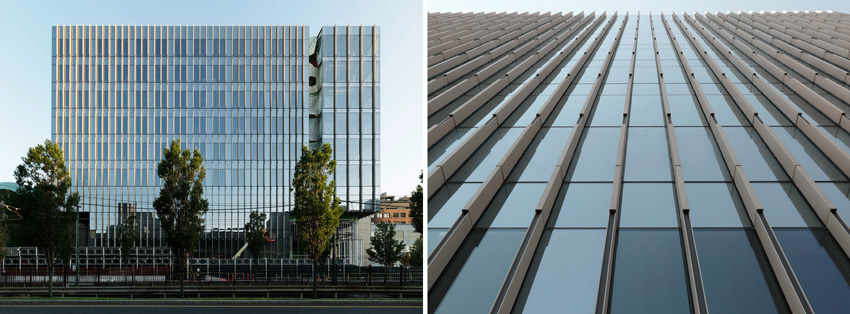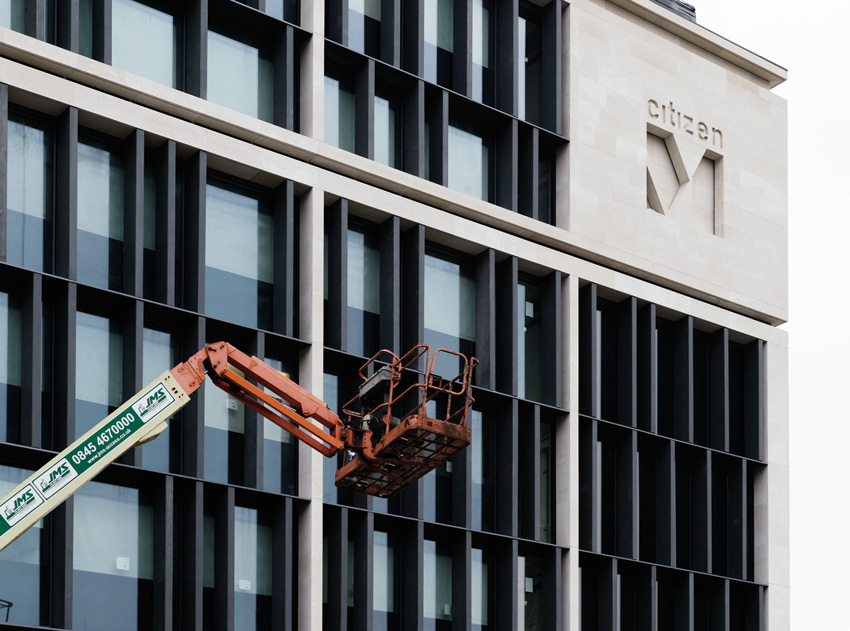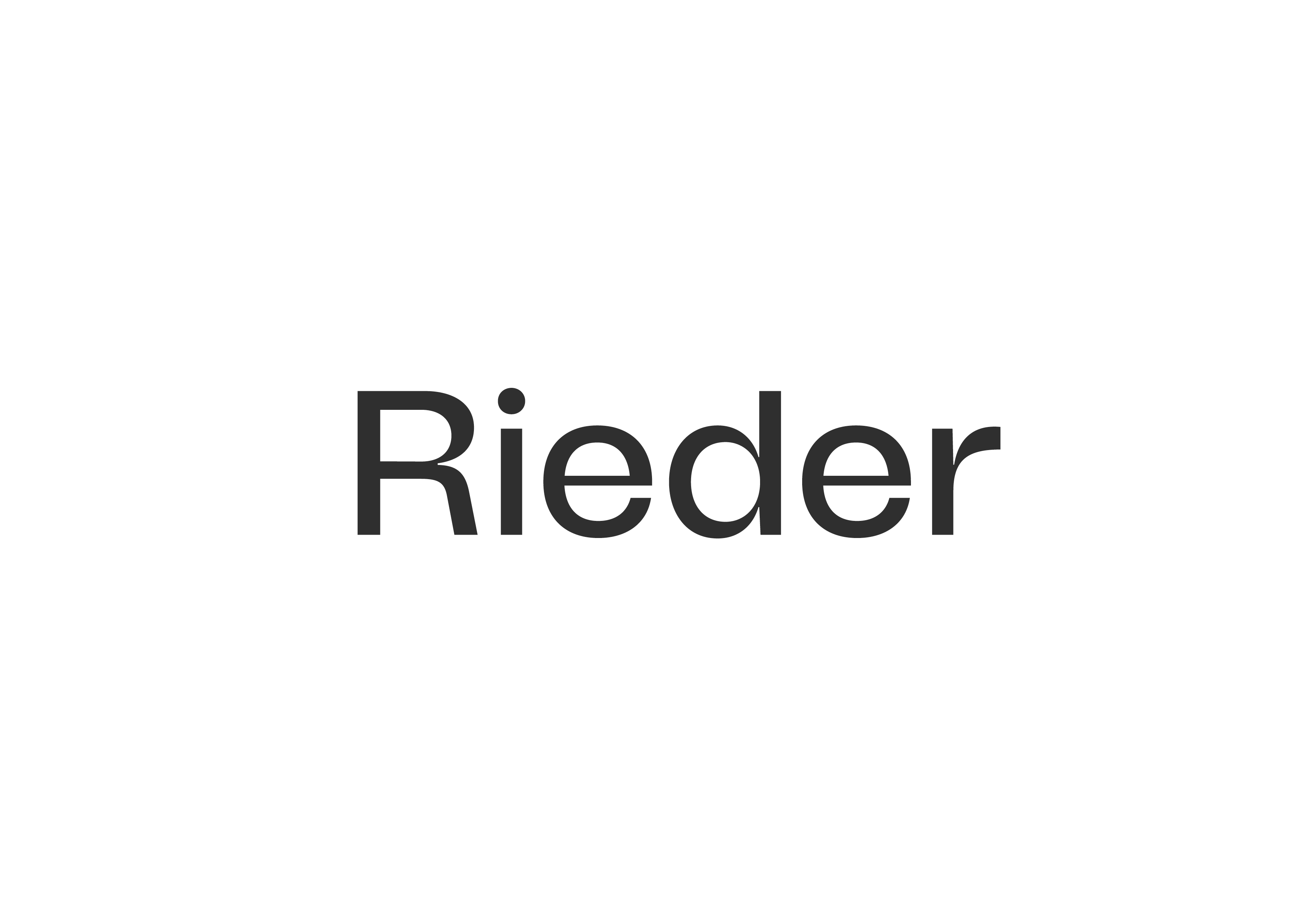This CE Center article is no longer eligible for receiving credits.
Rainscreen systems can help protect a building from wind, rain, and all forms of extreme weather. Until recently, the materials available for rainscreens were aluminum panels, phenolic panels, or fiber cement panels. The availability of extruded concrete is changing the game. Appropriate for both rainscreen applications and other exterior facade features, extruded concrete is thin, light, strong, and noncombustible. It is available in many colors and even can be incorporated in panelized or unitized applications. This course will compare extruded concrete to other rainscreen material options and describe the many benefits of using extruded concrete in your next rainscreen application.
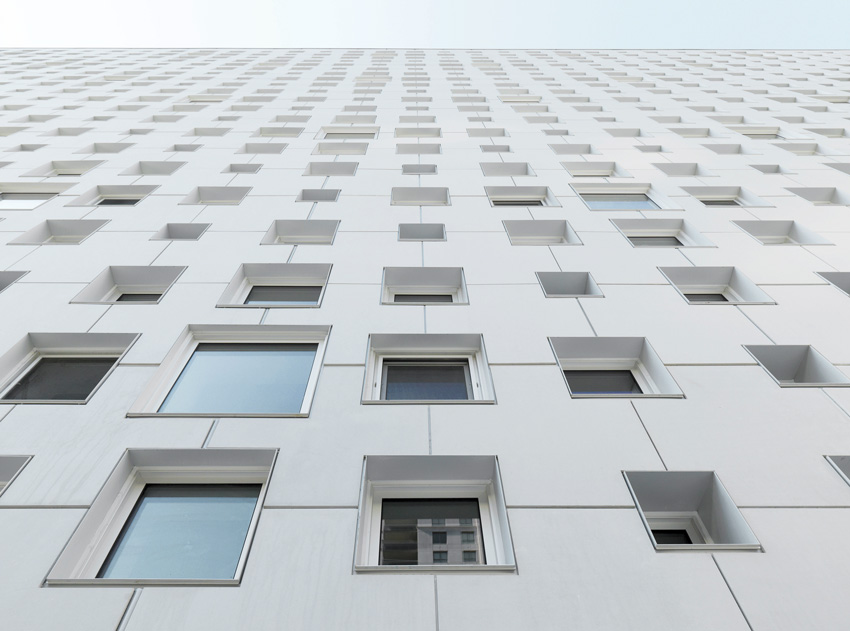
© Ditz Fejer
Available in many organic colors, thin, light, and durable extruded concrete panels can be part of an effective rainscreen system.
What is a Rainscreen?
A rainscreen is an exterior wall detail in which the exterior cladding or siding is installed with a small air gap between the cladding and the rest of the wall assembly. This space helps to create a capillary break and provides a path for moisture to exit the building envelope. This strategy not only enhances the durability and longevity of the building, but it also contributes to the health and well-being of occupants.
While some refer to the air gap and others to the cladding material when discussing rainscreens, in actuality, a rainscreen is a system that includes three essential components: the exterior cladding (the “screen”), a sealed air gap, and a water-resistive barrier, or WRB.
The rainscreen assembly also must include openings or vents that connect the air gap to the outside. Some rainscreen systems only include vents (or “weep holes”) at the bottom of the assembly, while others include vents at both the top and bottom of the wall. These components work together to protect the structure by controlling external moisture so that it does not reach the building’s substructure.
How Rainscreens Work
A rainscreen assembly helps keep water out of the building interior by providing a barrier against the water outside and controlling any water that makes it past the cladding. The internal air gap and WRB ensure that any water that makes its way in either evaporates or is drained through the gap and back outside. Some systems work to force air through the wall cavity/air gap to moderate the pressure differential between the exterior and interior wall, thus reducing the amount of moisture that is drawn into the building.
The air gap creates a path for liquid water to drain out of the envelope; it also creates a capillary break between the cladding and the WRB. An assembly that includes ventilation at both the top and bottom of a wall can dry out more quickly. This is because air rises as it is heated, a phenomenon known as the stack effect. A gap as small as 1/16 inch will provide a capillary break; however, most rainscreen assemblies include an air gap that is at least ¼ inch and up to 3/4 inch wide.
There are several ways to create the air gap. Many builders use vertical wood furring strips that are made on-site and attach directly to the studs. Other options include plastic mesh and textured or “bumpy” housewraps. Some of these materials allow for horizontal air movement as well as vertical venting.
Moisture management is a rainscreen’s raison d’etre. The main benefit of a rainscreen is that it facilitates the drying of the sheathing should moisture accumulate there. It also helps cladding that has become wet from precipitation dry out. The long-term benefits of moisture management include a healthier, more durable building. To understand these benefits, let’s take a look at the ways moisture can intrude upon the building envelope.
The Risks of Water Infiltration
When it comes to understanding the behavior of moisture in buildings, it’s important to remember that water follows the path of least resistance. Buildings receive moisture in the form of “bulk moisture.” This liquid moisture can contact buildings in the form of precipitation (rain and snow) or as flowing groundwater (flooding). Moisture in the air will condense on surfaces when the surface temperature falls below the dew point. Water also can enter a building at the time of construction if building materials aren’t adequately dry.
Roofing and exterior walls receive the impact of bulk water when it rains or snows; however, while roofing systems are designed to shed water downward to the eaves, exterior walls are more exposed to variations in water flow.
The exterior material impacts how water behaves. For example, because masonry is porous, a masonry wall will absorb water unless it has been protected with a water-resistant seal. Water that permeates through an unsealed masonry wall will eventually dry unless it encounters a weak spot in the joints.
When water encounters a nonporous material—for example, metal or glass—it follows the path of least resistance and trickles downward. However, wind can push it in any direction, even up under a roof. Wind can also push water through weak points in the exterior cladding.
Moisture damage is every builder’s nightmare. Moisture damage can compromise a building’s structural integrity, and groundwater entry from flooding can cause lasting damage to the building’s foundation. Trapped moisture can create conditions that lead to rot, mold growth, and/or insect infestation.
Increasingly, building professionals are recognizing the link between moisture and the health and well-being of building occupants. Many moisture-compromised materials release volatile organic compounds (VOCs) as they degrade, which can negatively impact health with long-term exposure. Moisture inside buildings can lead to mold and mildew growth, and it also creates ideal conditions for certain bacteria and dust mites. The presence of these, in turn, can aggravate allergies and respiratory conditions such as asthma. Often occupants suffer symptoms for months without realizing their homes or workspaces are making them sick.
A Comprehensive Strategy
Most building codes do not require rainscreens, although Oregon requires them in new residential construction, and British Columbia requires them in coastal areas. Though rainscreens require additional labor and materials, the benefits usually far outweigh the cost, and rainscreens have become standard practice in areas such as the Pacific Northwest.
Because moisture in buildings is such a serious problem, building professionals should plan a comprehensive water mitigation strategy early on in the design process. In environments that experience high humidity and frequent rainfall—for example, coastal zones—a rainscreen system can play a key role in a comprehensive strategy for keeping water out of the building.
Rainscreen systems can help protect a building from wind, rain, and all forms of extreme weather. Until recently, the materials available for rainscreens were aluminum panels, phenolic panels, or fiber cement panels. The availability of extruded concrete is changing the game. Appropriate for both rainscreen applications and other exterior facade features, extruded concrete is thin, light, strong, and noncombustible. It is available in many colors and even can be incorporated in panelized or unitized applications. This course will compare extruded concrete to other rainscreen material options and describe the many benefits of using extruded concrete in your next rainscreen application.

© Ditz Fejer
Available in many organic colors, thin, light, and durable extruded concrete panels can be part of an effective rainscreen system.
What is a Rainscreen?
A rainscreen is an exterior wall detail in which the exterior cladding or siding is installed with a small air gap between the cladding and the rest of the wall assembly. This space helps to create a capillary break and provides a path for moisture to exit the building envelope. This strategy not only enhances the durability and longevity of the building, but it also contributes to the health and well-being of occupants.
While some refer to the air gap and others to the cladding material when discussing rainscreens, in actuality, a rainscreen is a system that includes three essential components: the exterior cladding (the “screen”), a sealed air gap, and a water-resistive barrier, or WRB.
The rainscreen assembly also must include openings or vents that connect the air gap to the outside. Some rainscreen systems only include vents (or “weep holes”) at the bottom of the assembly, while others include vents at both the top and bottom of the wall. These components work together to protect the structure by controlling external moisture so that it does not reach the building’s substructure.
How Rainscreens Work
A rainscreen assembly helps keep water out of the building interior by providing a barrier against the water outside and controlling any water that makes it past the cladding. The internal air gap and WRB ensure that any water that makes its way in either evaporates or is drained through the gap and back outside. Some systems work to force air through the wall cavity/air gap to moderate the pressure differential between the exterior and interior wall, thus reducing the amount of moisture that is drawn into the building.
The air gap creates a path for liquid water to drain out of the envelope; it also creates a capillary break between the cladding and the WRB. An assembly that includes ventilation at both the top and bottom of a wall can dry out more quickly. This is because air rises as it is heated, a phenomenon known as the stack effect. A gap as small as 1/16 inch will provide a capillary break; however, most rainscreen assemblies include an air gap that is at least ¼ inch and up to 3/4 inch wide.
There are several ways to create the air gap. Many builders use vertical wood furring strips that are made on-site and attach directly to the studs. Other options include plastic mesh and textured or “bumpy” housewraps. Some of these materials allow for horizontal air movement as well as vertical venting.
Moisture management is a rainscreen’s raison d’etre. The main benefit of a rainscreen is that it facilitates the drying of the sheathing should moisture accumulate there. It also helps cladding that has become wet from precipitation dry out. The long-term benefits of moisture management include a healthier, more durable building. To understand these benefits, let’s take a look at the ways moisture can intrude upon the building envelope.
The Risks of Water Infiltration
When it comes to understanding the behavior of moisture in buildings, it’s important to remember that water follows the path of least resistance. Buildings receive moisture in the form of “bulk moisture.” This liquid moisture can contact buildings in the form of precipitation (rain and snow) or as flowing groundwater (flooding). Moisture in the air will condense on surfaces when the surface temperature falls below the dew point. Water also can enter a building at the time of construction if building materials aren’t adequately dry.
Roofing and exterior walls receive the impact of bulk water when it rains or snows; however, while roofing systems are designed to shed water downward to the eaves, exterior walls are more exposed to variations in water flow.
The exterior material impacts how water behaves. For example, because masonry is porous, a masonry wall will absorb water unless it has been protected with a water-resistant seal. Water that permeates through an unsealed masonry wall will eventually dry unless it encounters a weak spot in the joints.
When water encounters a nonporous material—for example, metal or glass—it follows the path of least resistance and trickles downward. However, wind can push it in any direction, even up under a roof. Wind can also push water through weak points in the exterior cladding.
Moisture damage is every builder’s nightmare. Moisture damage can compromise a building’s structural integrity, and groundwater entry from flooding can cause lasting damage to the building’s foundation. Trapped moisture can create conditions that lead to rot, mold growth, and/or insect infestation.
Increasingly, building professionals are recognizing the link between moisture and the health and well-being of building occupants. Many moisture-compromised materials release volatile organic compounds (VOCs) as they degrade, which can negatively impact health with long-term exposure. Moisture inside buildings can lead to mold and mildew growth, and it also creates ideal conditions for certain bacteria and dust mites. The presence of these, in turn, can aggravate allergies and respiratory conditions such as asthma. Often occupants suffer symptoms for months without realizing their homes or workspaces are making them sick.
A Comprehensive Strategy
Most building codes do not require rainscreens, although Oregon requires them in new residential construction, and British Columbia requires them in coastal areas. Though rainscreens require additional labor and materials, the benefits usually far outweigh the cost, and rainscreens have become standard practice in areas such as the Pacific Northwest.
Because moisture in buildings is such a serious problem, building professionals should plan a comprehensive water mitigation strategy early on in the design process. In environments that experience high humidity and frequent rainfall—for example, coastal zones—a rainscreen system can play a key role in a comprehensive strategy for keeping water out of the building.
Common Rainscreen Materials
As part of a water mitigation system, rainscreens first and foremost need to repel water. However, they also need to be durable enough to withstand other environmental forces such as wind, UV radiation, and extreme heat and cold.
Many types of siding or cladding materials can be part of an effective rainscreen system. Designers must weigh a number of factors when specifying this material, including the desired aesthetics, fire resistance, sustainability, installation requirements, lifetime maintenance, and project budget.
Architects and designers have a wide range of options for materials that can serve as part of a rainscreen assembly while also contributing to an aesthetically beautiful building envelope. Some of the materials commonly used for rainscreens include wood, aluminum composite (ACM), stone, cement board and fiber cement, high-pressure laminate (HPL), reconstituted stone, terra cotta, ceramic tile, glass reenforced plastic (GRP), and fibrous concrete. More recently, extruded concrete has emerged as an effective and desirable option. In this course, we will focus on wood-plastic composite, cement board and fiber cement, cast-in-place concrete, and extruded concrete.
Wood-Plastic Composite
As the name implies, wood-plastic composite (WPC) is a composite material comprised of plastic and wood fibers that are bonded together. Available as panels or planks, the material is often designed to mimic conventional wood cladding and encapsulated in a durable polymer shell. As with wood, it can be painted and is a cost-effective alternative for some applications. WPC is often touted as a material that boasts the aesthetic benefits of wood but without the maintenance.
WPC is resistant to fire, rot, and insect infestations, and when made with recycled wood fibers and plastics, it can be a sustainable choice. It is also a durable material with a 30-year lifespan if properly maintained.
Wood-plastic composite products are manufactured by mixing finely ground wood particles with heated thermoplastic resins. The material is typically extruded, but it can be injection molded. Depending on the manufacturer, varying amounts of recycled wood and plastic components are used.
Cement Board and Fiber Cement
Cement boards are large, thin sheets made with cement and reinforcing fibers. Cement bonded particle board is reinforced with wood flakes and typically comes in 4-by-8 and 3-by-5 panels. This versatile material, often called “backerboard,” can be nailed or screwed to building structures to serve as a substrate for tile floors, kitchen counters, and backsplashes. It also can be used in building exteriors as a base for stucco, or it can serve as the exposed siding. As a rainscreen material, cement board offers durability, strength, and moisture resistance, although it is relatively heavy.
Increasingly popular as a durable siding choice, fiber cement is a mixture of cement and sand reinforced with cellulose fibers. It comes in panels and planks of varying widths, and at least one manufacturer offers prepainted products. Fiber cement siding is a durable, low-maintenance siding choice for rainscreen applications, but it is relatively heavy and requires specialized tools.
Fiber cement is manufactured by combining wet cement, sand, and cellulose fibers into a slurry. The mixture is then pressed, dewatered, and cured through an autoclaving process. The material can be imprinted with wood grain or other patterns.
Cast-in-Place Concrete
Cast-in-place concrete is a mixture of aggregate and sand that is delivered ready mixed in an unhardened state to the project site. The concrete is poured into molds, which often utilize rebar or other materials to reinforce the finished product. The particles are bonded together with cement. In addition to being used for building foundations, cast-in-place concrete can be used to construct beams, columns, floors, roofs, and walls. This type of concrete is very strong and durable. It is often touted as a sustainable solution because materials are usually locally sourced, and unused product can be saved and reused for other projects. Cast-in-place concrete also has high thermal mass, and it can improve a building’s energy performance by creating an air barrier. The material’s light color helps reduce the heat island effect by reflecting rather than absorbing heat—a beneficial feature when using cast-in-place concrete for an exterior rainscreen.
Extruded Concrete
Extruded concrete typically refers to thin concrete panels that are reinforced with glass fiber. Also called glass fiber-reinforced concrete, the material usually includes a ratio of 90 percent sand and 10 percent glass fibers, plus concrete additives and pigments. Panels are colored all the way through and available in dimensions up to 177 inches long and 48 inches wide.
Extruded concrete panels are ultra-thin and lightweight. With a typical thickness of 13 millimeters (about half an inch), they are half the thickness of cast concrete. The material is exceptionally strong, lightweight, and durable, making it an ideal choice for rainscreen applications. It even can be formed into shapes that create sophisticated architectural facades, which also provide shading and other energy-performance benefits. The panels are noncombustible and appropriate for fire-resistant assemblies.
Extruded concrete panels are made by laying down several 3-millimeter-thick layers of concrete layered and mixed with glass fiber mesh and short strands of glass fibers. The extrusion process can quickly create very thin and strong concrete panels in a wide range of colors and surface treatments.
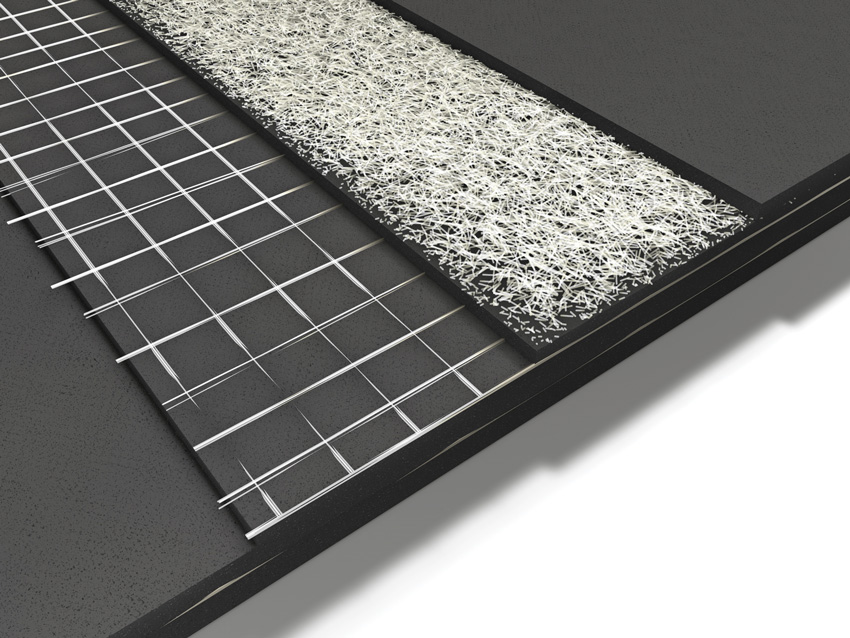
Image courtesy of Rieder North America
The glass fibers embedded in the concrete panels give them a high strength-to-weight ratio, enabling thin, lightweight panels.
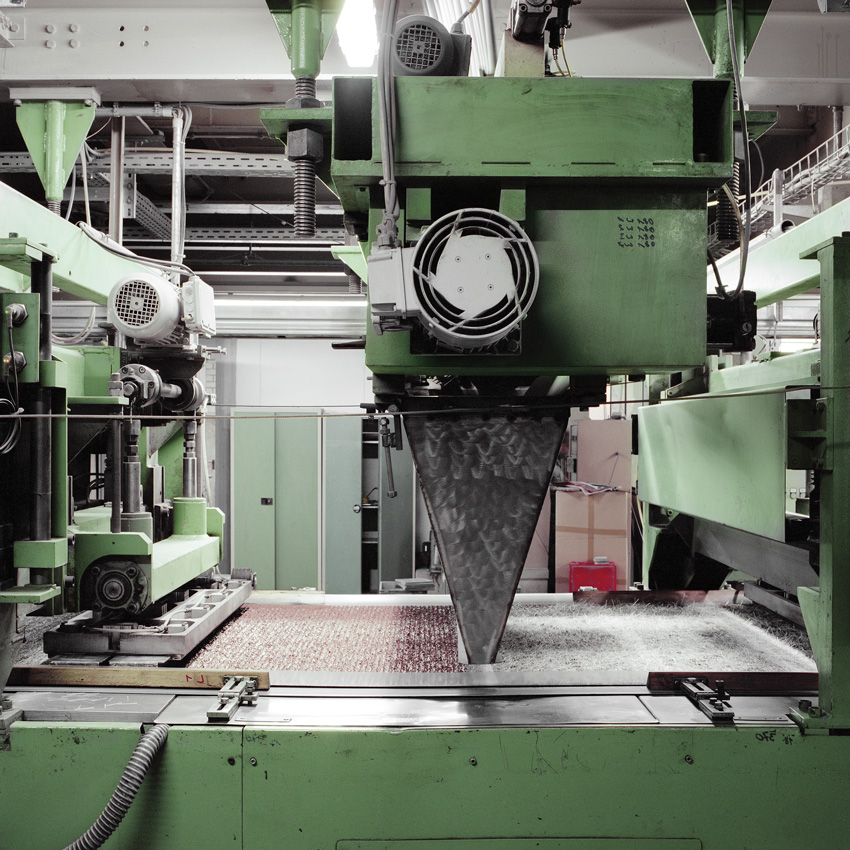
Photo courtesy of Rieder North America
During the manufacturing process, chopped glass fibers are embedded into the concrete mix.
Comparing Rainscreen Materials
The goal of a rainscreen is not only to prevent moisture from entering the building shell but also to provide an internal means of water drainage and evaporation if water does get through. A good rainscreen will accomplish the “4 Ds”: deflect water, drain moisture, dry any water that has penetrated the cladding, and be durable enough to withstand the elements over time without deteriorating.
Rainscreens must be strong enough to withstand extreme weather conditions, yet they must also be as light as possible to minimize the amount of additional framing support required. In addition, they need to offer a reasonable amount of design flexibility. Let’s take a look at how the commonly used materials introduced earlier stack up when it comes to the most important considerations of design and performance.
Water mitigation: Wood-plastic composite, fiber cement, cast-in-place concrete, and extruded concrete are all highly moisture resistant. The main issue with cement board is the cellulose wood fiber, which can wick water into the core and cause failure; this is also a fire issue. Because extruded concrete uses glass fiber, it does not absorb water and does not burn.
Fire resistance: One of the downsides of wood-plastic composite products is that they are not fire resistant unless treated. Some manufacturers include fire retardants in their WPC products; however, these chemicals raise concerns about health and environmental impacts. All of the concrete-based products are either noncombustible or fire resistant and can be part of fire-resistant assemblies.
Health and toxicity: Some wood-plastic composite products contain pollvinyl chloride, or PVC, which releases dioxins during production and when incinerated. Dioxins are known carcinogens and are linked to a range of other health issues, including birth defects. Many fiber cement products contain crystalline silica, which is a known carcinogen. The other concrete-based products, including extruded concrete, do not contain this material.
Weight: Material weight is an important consideration that impacts both transportation cost and laborers performing the installation. Different panel sizes and thicknesses may be appropriate for different projects.
Cast-in-place concrete differs from the other materials as it is delivered in a ready-mix form and poured on-site. However, the cured product is heavy, and molds are seldom thinner than 1 inch thick.
Strength: As with any exterior cladding, the material used in rainscreen assemblies must be able to withstand high winds, wind-driven rain and hail, and even wind-borne debris impacts. The material also should be able to withstand temperature fluctuations and freeze-thaw cycles without cracking.
By some strength measures, wood-plastic composites are inferior to wood; however, the material gets high marks for compressive strength. Concrete-based materials are very strong; however, cast-in-place concrete can degrade if the internal rebar comes in contact with water and begins to rust. Concrete also can develop pressure cracks when placed under heavy loads. Here extruded concrete has an advantage. The embedded glass fibers give extruded concrete panels an extremely high strength-to-weight ratio; the material is also highly ductile and stable.
Durability: Exterior cladding is exposed continually to the elements, yet it must perform for the life of the building. Wood-plastic composite and all of the concrete-based products score high in durability, especially compared to wood; however, as mentioned above, rust can compromise the integrity of cast-in-place concrete.
Design flexibility and aesthetics: Exterior cladding contributes to a building’s aesthetic. Consequently, rainscreen materials should ideally perform their functions but also include a range of choices when it comes to color, shape, and surface texture.
WPC products can convincingly mimic wood and can be painted or stained, but without the required maintenance of the real thing. Similarly, fiber cement can be embossed with wood grain but also comes in a smooth finish, depending on the desired aesthetic. The material comes in panels or planks, accommodating a range of architectural styles. Cement board and cast-in-place concrete both can be polished, sandblasted, or honed smooth for different surface textures, and cast-in-place concrete can be poured into many shapes.
Made of mineral-based raw materials, extruded concrete has an organic aesthetic that is compatible with many architectural styles. Many standard and custom colors and various surface treatments are possible, all of which influence its character. Extruded concrete can be formed into flat panels and/or three-dimensional shapes, giving designers a wide range of options for creating dynamic and attractive facades.

© Ditz Fejer
Extruded concrete panels are typically colored using ferric oxide-based colors and natural additives; the panels are subsequently brushed or sandblasted, rendering them with an organic aesthetic that blends in well with natural landscapes.
Sustainability
There are many factors to consider when evaluating the sustainability of a rainscreen material, including durability, embodied energy, recycled content, recyclability, health, and contributions to energy performance.
All of the rainscreen options discussed are highly durable and thus contribute to the building’s longevity—and hence, its sustainability. Extruded concrete has an additional benefit in that facade elements will contribute to shading, potentially lowering the energy required to cool the building.
Wood-plastic composites include plastics, which have high embodied energy and emit harmful VOCs during their manufacturing process; however, most WPC manufacturers include a percentage of recycled plastic in their products. Cement has high embodied energy; consequently, this is a consideration for any concrete product or material that contains cement. However, extruded concrete panels are light and thin and so require a smaller amount of concrete. In addition, the manufcturing process is less energy intensive since the panels are cured at room temperature. Fiber cement, in contrast, requires high-temperature autoclaving.
The recycled content in WPC products—both for the wood fibers and the plastic material—is potentially very high, and the percentage of recycled versus virgin plastic greatly impacts the embodied energy (and overall sustainability) of the product. Some fiber cement manufacturers include cement with a certain percentage of fly ash and/or recycled glass in their products. Concrete is made of abundant natural materials and can include some recycled aggregate.
Wood-plastic composite products are difficult to recycle since the plastic and wood materials are bound together; however, they can be recycled into new WPC products. Fiber cement is theoretically recyclable, but no ready markets exist. Crushed concrete can be used as aggregate to make new concrete, and used concrete products, including extruded concrete panels, can be crushed and used as fill.
Extruded Concrete Panels: The Benefits
Extruded concrete is an ideal and increasingly popular rainscreen material. It is thin, light, strong, and noncombustible, passing the stringent ASTM 136 fire rating test; in addition, it is available in a wide range of colors and can be molded into “fins” that shade a building, reducing solar heat gain. Let’s take a closer look at the many benefits of this versatile material.
Physical properties: The physical properties of extruded concrete combine the advantages of concrete and glass. One of the material’s greatest advantages is its thickness tolerance. The product’s composition, with its alternating layers of concrete and glass fiber, make for a material with high tensile strength and durability.
The panels are made by alternating 3-millimeter layers of concrete and glass fiber mesh. The layers repeat until the panel is 13 millimeters (about half an inch) thick, making for a panel with high tensile strength and durability.
Production capability: The extrusion process is quick and efficient, boosting production capacity. Some manufacturers can produce up to 30,000 square feet per day.
One of the limitations of extruded concrete is that panel width is determined by the width of the machine. For example, if a machine is 48 inches wide, panels are limited to four feet in width.
Maintenance: Extruded concrete panels require very little if any maintenance at all. This is a huge advantage, especially compared to a material such as wood cladding, which requires staining, painting, or other treatment in order to maintain its appearance and durability. Extruded concrete panels, on the other hand, retain their aesthetics throughout the lifetime of the product. The low manintence requirements also contribute to the product’s overall sustainability, as paints and stains contribute to the lifetime embodied energy of other cladding materials.
Health and safety: Because glass fiber-reinforced concrete is a noncombustible material as per ASTM E-136, it can play a key role in fire-resistant assemblies, thereby protecting life safety of occupants. The material also maintains temperature stability up to 350 degrees Celsius. It requires no additional treatment or chemical retardants, and it does not contain crystalline silica or other harmful substances. The zero-VOC product does not off-gas harmful substances, and its effectiveness in rainscreen assemblies ensures not only the longevity of the building but also that it will not contribute to conditions that promote mold or mildew, which can compromise indoor air quality.
Sustainability: Extruded concrete panels are naturally cured at room temperature, typically for 28 days. This translates into low energy use. The manufacturing of extruded concrete panels requires less energy than several other popular cladding options, ranking lower in primary energy content, global warming potential, and acidification than fiber cement, aluminum, and high-pressure laminate panels. In addition, extruded concrete panels are 90 percent thinner than conventional concrete panels, requiring fewer materials and less substructure. Extruded concrete panels contribute to the longevity of buildings, and ultimately, the material is 100 percent recyclable.

Images courtesy of Rieder North America
The greenhouse gas potential of extruded concrete production is 90 percent less than aluminium sheeting (left), and the production of extruded concrete consumes 85 percent less primary energy than high-pressure laminate panels (right).

© Rasmus Norlander
Extruded concrete panels can help projects earn ceritification under green building programs, such as LEED. The Main Point Karline office tower in Prague, which features colorful extruded concrete facade elements, is LEED Platinum certified.
Aesthetics and design flexibility: Extruded concrete panels present architects with exciting design opportunities. The panels can be installed with either exposed or concealed fasteners (adhesive or undercut) depending on the desired aesthetic. The panels come in a range of colors and surface finishes; some manufacturers also offer custom colors. Earth-based pigments, like iron oxide, impart a “natural” look to the material, helping buildings blend with the surrounding environment. At least one manufacturer even offers a slat “building skin” product that mimics wood. The full integration of the pigment with the raw material also ensures consistent quality compared to products that are only treated on the surface. In addition, surfaces can be treated to create textures from brushed matte to sandblasted (heavily textured).
Some manufacturers also offer other surface treatments. These include perforation, in which individual shapes or letters are cut out of the panel using a water jet, and sandblasting, a process which applies patterns, characters, or logos to the panel surface. Digital and screen-printing enable images, photographs, designs, and text to be printed onto the panels, and relief treatments impart interesting textures.
One distinct design advantage is the variety of two- and three-dimensional shapes that are possible with glass fiber-reinforced concrete. The material can be formed into U- and L-shaped elements that create dynamic facades. Such elements also can function as solar shading on tall buildings—an option that puts extruded concrete panels in direct competition with the more conventional aluminum fins. Molds also can be used to create curved and arched components.
Finally, extruded concrete panels can be used in applications other than exterior rainscreens and facades. The material can serve as decking and benches. Inside, extruded concrete panels can enhance interior walls and even be formed into furniture and used as countertops and other surfaces.

© Ditz Fejer
Designers enjoy almost unlimited freedom when working with extruded concrete thanks to the extraordinary design variants that are possible, including colors, surfaces, print, perforation, sandblasting, relief, and shapes.
Installation: One of the advantages of extruded concrete is that fasteners can be preassembled. Pre-installing fastening brackets saves time and labor on the jobsite, as the assembly can simply be hung and fine-tuned. The manufacturer can work with your design team to develop the appropriate substructure and even simulate the assembly steps beforehand, ensuring a smooth installation.
Integrated design: Some manufacturers of extruded concrete panels offer optional services such as design development, facade optimization, static calculations, fastening methods, mockups and prototyping, element substructures, preassembly, and logistics concepts. For example, creating mockups can help design teams evaluate the concept, making sure it meets visual expectations. At the same time, a mockup can also be used for technical testing and the simulation of weathering and wind loads. These services can help ensure that the panels meet all of a project’s design goals, including timeline and budget.
Conclusion
Extruded concrete is quickly becoming a popular choice in rainscreen assemblies, outperforming the other concrete-based options in several categories. Rainscreen panels made from extruded concrete layered with glass fiber can be rapidly produced, and the finished product combines many of the desired attributes for quality rainscreens. Specifically, the panels are thin, lightweight, and strong but also durable and noncombustible. Available in a range of colors and surfaces, the material gives architects a wide range of design choices—not just for rainscreens but also for creating architecturally dynamic facades.
Andrew A. Hunt, is vice president of Confluence Communications and has been a writer and consultant in the green building and building science industry for over a decade. He has authored more than 100 continuing education and technical publications as part of a nationwide practice. www.confluencecommunications.com
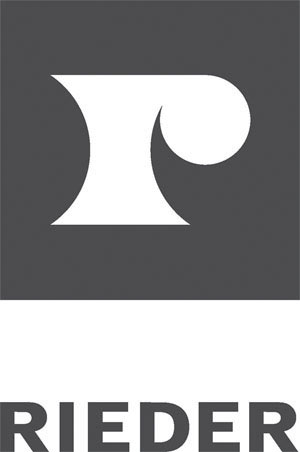
|
The diversity and high performance of fibreC glassfibre reinforced concrete allows for cost-saving construction of high-quality, cutting-edge facade systems with long-term durability. It is authentic and in line with the current trend toward natural and sustainable materials.
www.rieder.cc/us/en/
|








